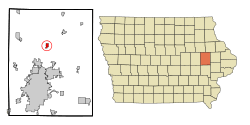Alburnett, Iowa facts for kids
Quick facts for kids
Alburnett, Iowa
|
|
|---|---|
| Motto(s):
"The comfort of country and community"
|
|

Location of Alburnett, Iowa
|
|
| Country | |
| State | |
| County | Linn |
| Incorporated | June 29, 1912 |
| Area | |
| • Total | 0.76 sq mi (1.97 km2) |
| • Land | 0.76 sq mi (1.96 km2) |
| • Water | 0.00 sq mi (0.01 km2) |
| Elevation | 883 ft (269 m) |
| Population
(2020)
|
|
| • Total | 675 |
| • Density | 892.86/sq mi (344.65/km2) |
| Time zone | UTC-6 (Central (CST)) |
| • Summer (DST) | UTC-5 (CDT) |
| ZIP code |
52202
|
| Area code(s) | 319 |
| FIPS code | 19-01000 |
| GNIS feature ID | 0454117 |
Alburnett is a small city in Linn County, Iowa, USA. It is part of the Cedar Rapids metropolitan area. In 2020, the city had a population of 675 people. Its motto is "The comfort of country and community."
Contents
History of Alburnett
Alburnett started because of the Illinois Central Railroad. In 1887, the railroad built tracks through Otter Creek township in Linn County. That winter, a train station was built on land given by a man named Albert Burnett. Because of his gift, the station and the new community were first called "Burnett."
Businesses began to grow around the train station. This was because the railroad made it easy to send goods north and south. Also, the area was close to Cedar Rapids, Iowa. Albert Burnett and his wife then started to plan out the town.
Nearby, another landowner, Michael Weislogel, also started to create lots for homes. This area was called "Trentham." It had the first general store and post office. However, a state law said that a train station and a post office in the same place had to have the same name. So, "Trentham" was also renamed "Burnett."
Soon, there were problems with mail delivery. Mail for "Burnett" was getting mixed up with mail for Bennett, another town in Iowa. To fix this, Albert Burnett changed the name of the town again. He added "Al" from his own name to "Burnett," creating "Alburnett." The city of Alburnett officially became a town in 1912.
Geography of Alburnett
Alburnett is located in Iowa. Its exact position on a map can be found using coordinates: 42.149257 degrees North and -91.619618 degrees West.
The United States Census Bureau says that the city covers a total area of about 0.76 square miles (1.97 square kilometers). All of this area is land.
Population and People
| Historical populations | ||
|---|---|---|
| Year | Pop. | ±% |
| 1920 | 201 | — |
| 1930 | 199 | −1.0% |
| 1940 | 208 | +4.5% |
| 1950 | 254 | +22.1% |
| 1960 | 341 | +34.3% |
| 1970 | 418 | +22.6% |
| 1980 | 411 | −1.7% |
| 1990 | 459 | +11.7% |
| 2000 | 559 | +21.8% |
| 2010 | 673 | +20.4% |
| 2020 | 675 | +0.3% |
| Source: and Iowa Data Center Source: |
||
The population of Alburnett has grown steadily over the years. In 1920, there were 201 people living there. By 2020, the population had grown to 675 people.
2020 Census Information
According to the census in 2020, 675 people lived in Alburnett. There were 246 households, which are groups of people living together in one home. Most of the people living in Alburnett were White (94.4%). About 28% of the residents were under 20 years old. The average age in the city was 40.8 years. The population was almost evenly split between males (52%) and females (48%).
2010 Census Information
In the 2010 census, Alburnett had 673 people. There were 243 households. About 44.4% of these households had children under 18 living with them. Most residents (98.1%) were White. The average age was 35.5 years. About 31.5% of the people were under 18 years old.
Education in Alburnett
Alburnett is home to the Alburnett Community School District. This school system serves students in Linn County. It includes all of Alburnett and the nearby town of Toddville. It also covers parts of Marion, Robins, and Hiawatha.
All students, from preschool (PK) to 12th grade, go to school in different parts of the same building in Alburnett. The school district has a Superintendent, a Principal for middle and high school (grades 6-12), and a Principal for elementary school (grades PK-5). There is also an Activities Director who manages sports and other school events.
Alburnett High School sports teams are called the Pirates. Their school colors are purple and gold. They compete in the Tri-Rivers Conference in eastern Iowa.
A famous person who went to Alburnett High School is actor Riley Smith. He has appeared in TV shows like Dawson's Creek and 24. He was also in movies such as Radio.
Images for kids
See also
 In Spanish: Alburnett para niños
In Spanish: Alburnett para niños


